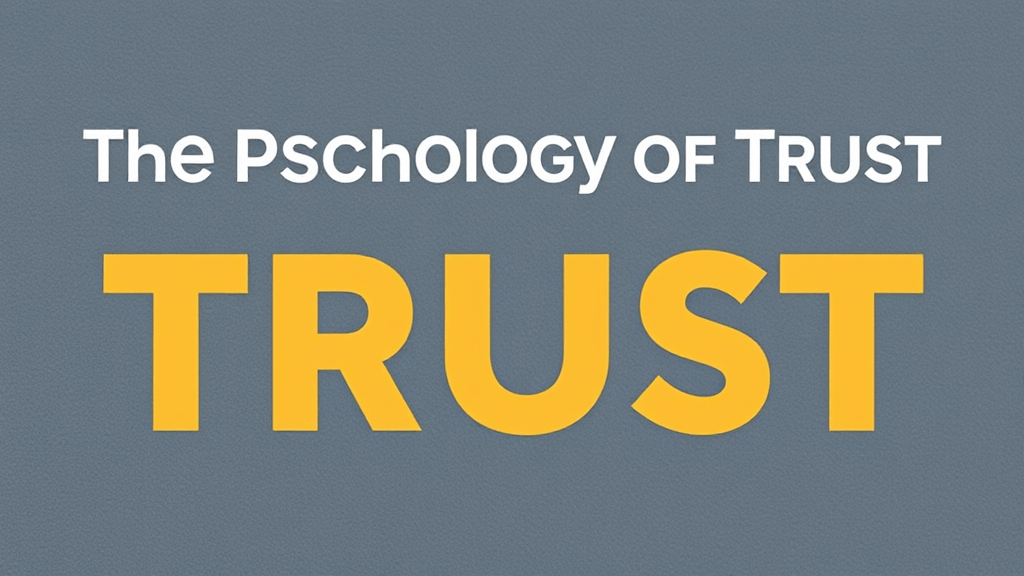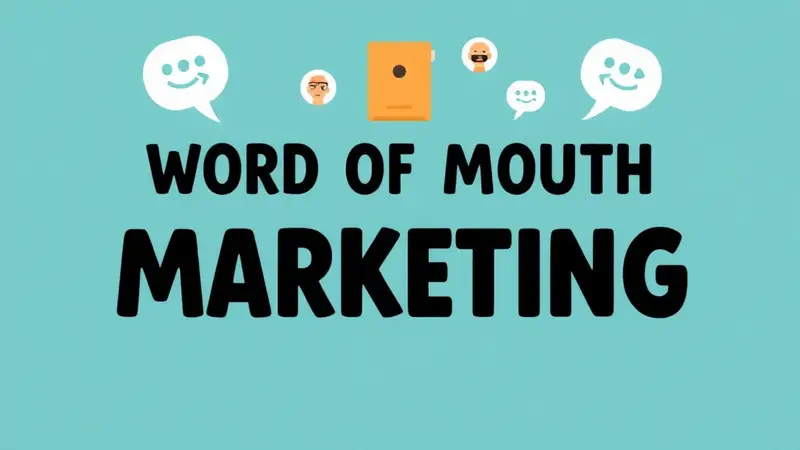Trust is the most valuable currency for small businesses. Without it, even the best products or services will struggle to gain traction. Did you know that 81% of consumers say trust influences their buying decisions[1]? Customers today are more skeptical than ever, and they want reassurance before spending their hard-earned money.
For small businesses, trust isn’t just a nice-to-have—it’s essential for survival. Unlike big brands that benefit from widespread recognition, small businesses must work harder to prove their credibility and earn customer loyalty.
This guide will break down the psychology of trust and provide actionable strategies for how small businesses build trust and increase customer loyalty.
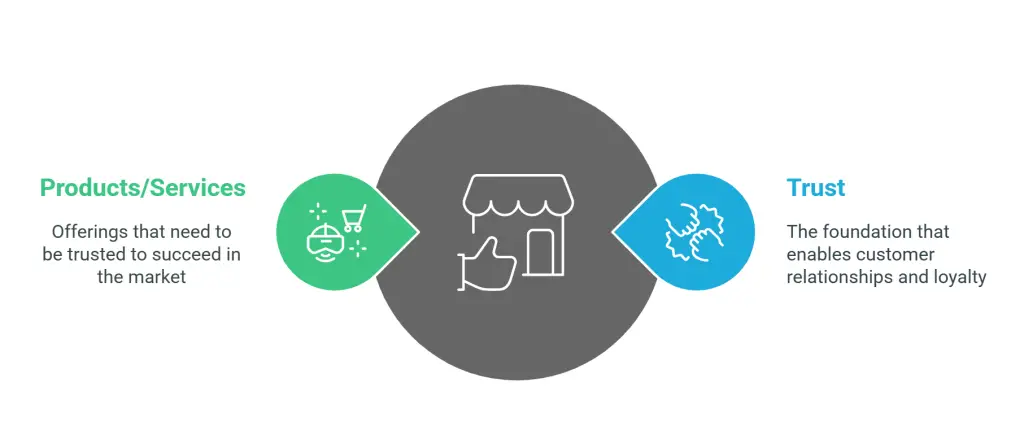
The Psychology Behind Trust in Business
Why Trust Reduces Buyer Hesitation
Customers hesitate to buy when they feel uncertain. This hesitation stems from the fear of making a bad decision—whether it’s wasting money, receiving poor service, or not getting what they expected.
When a small business demonstrates reliability, transparency, and consistency, it removes uncertainty and makes it easier for customers to say ‘yes’.
Trust also plays a critical role in the decision-making process. When customers feel safe and confident in their purchase, they are more likely to move forward without hesitation. Studies show that businesses that emphasize trust-building in their branding and interactions experience higher conversion rates and increased customer retention.
Additionally, the emotional component of trust cannot be overlooked. Consumers often make decisions based on feelings rather than pure logic. If a brand evokes feelings of security, reliability, and authenticity, potential buyers are more likely to engage and make repeat purchases.
To reduce buyer hesitation, small businesses should focus on clear communication, providing detailed product or service information, and offering risk-reducing measures such as money-back guarantees or warranties. These elements reassure customers that their decision is protected, further fostering confidence in the brand.
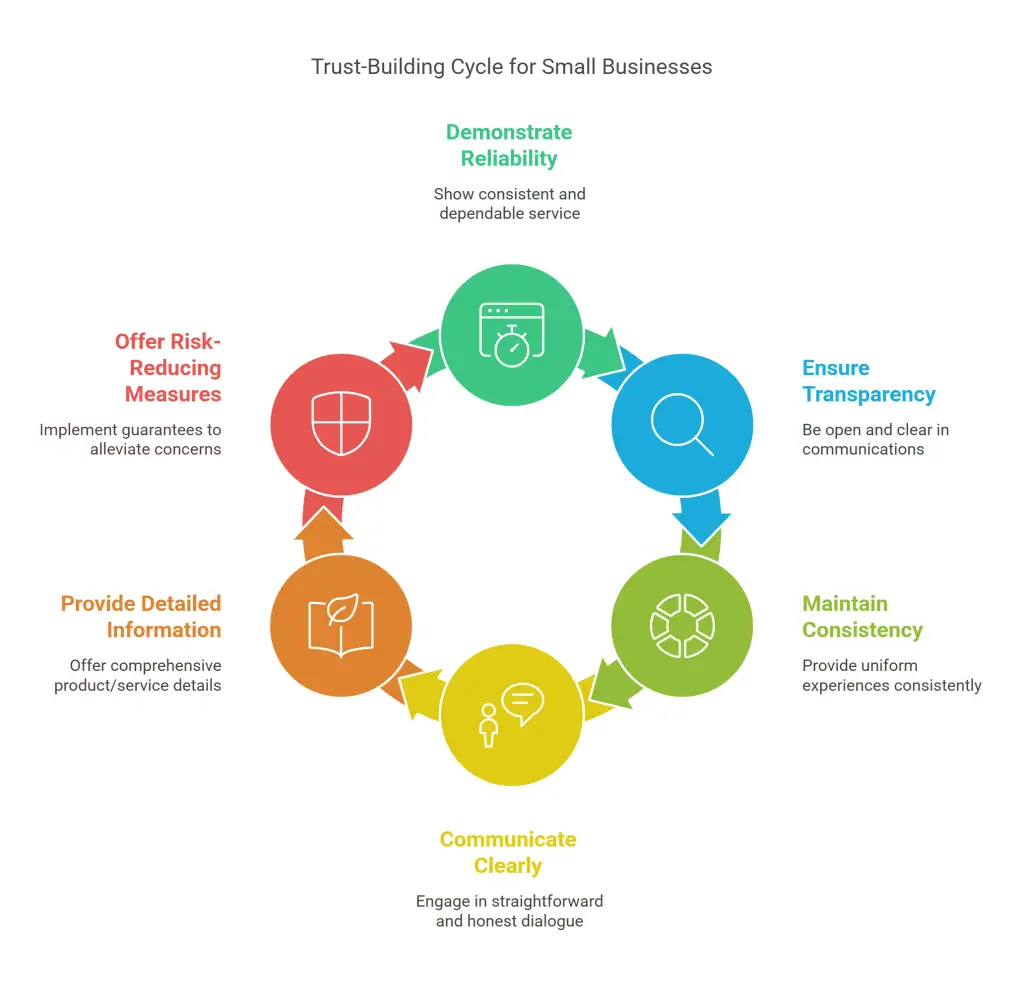
First Impressions & Credibility
The first interaction a potential customer has with your business—whether it’s visiting your website, walking into your store, or seeing your social media profile—sets the tone for trust.
Key Elements of a Trustworthy First Impression:
✅ A professional, user-friendly website (no outdated design or broken links)
✅ A clear and compelling brand message (what do you do, and why does it matter?)
✅ Contact information displayed clearly (makes you feel approachable)
✅ Authentic images and testimonials instead of generic stock photos
Beyond the physical or digital appearance, tone and communication style also play a major role in establishing trust. Customers want to feel heard and understood. Using clear, empathetic, and professional language in customer interactions—whether through website copy, emails, or customer support—can create an immediate sense of reliability.
Another key factor in credibility is social validation. A business that is actively engaged with its audience, has a strong presence on review platforms, and is endorsed by satisfied customers will instantly appear more trustworthy than one with little to no social proof.
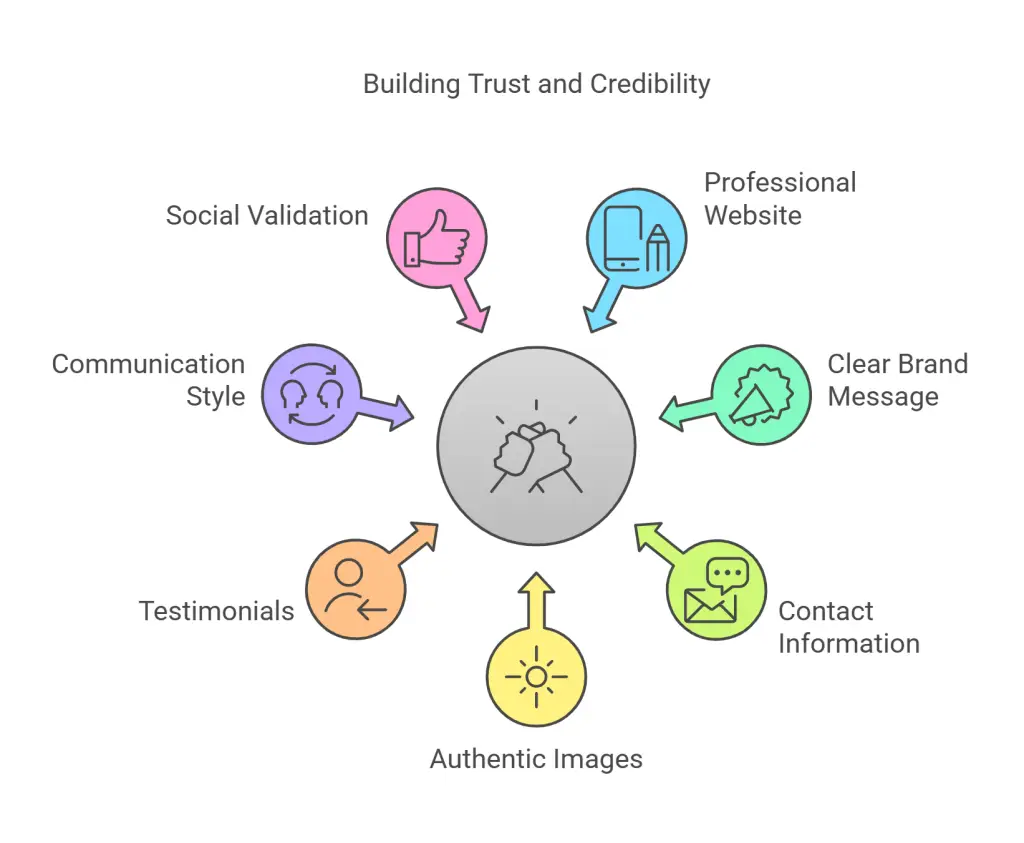
The Importance of Consistency
A brand that is inconsistent in messaging, customer service, or quality erodes trust. Customers want to know exactly what to expect every time they interact with your business.
Consistency goes beyond just branding. It extends to customer experience across all touchpoints. Whether a customer engages with a business through its website, social media, email support, or in person, the experience should remain uniform and dependable. A business that frequently changes its tone, pricing, or level of customer service can cause confusion and skepticism among potential buyers.
Example: If a café has great service one day but is unresponsive on social media or inconsistent with order quality, trust weakens. Customers begin to question whether their experience will always be positive or if it’s just a matter of luck.
Building Consistency Into Your Brand
To build trust through consistency, small businesses should focus on these areas:
✅ Brand Messaging: Ensure that website content, advertisements, and social media posts all reflect the same voice, tone, and values.
✅ Customer Service Standards: Set clear guidelines for response times, support interactions, and dispute resolutions to maintain reliability.
✅ Quality Control: Whether it’s a product or a service, maintaining the same level of quality across all transactions reinforces trust.
✅ Regular Engagement: Stay active and responsive on social media, emails, and customer inquiries to show reliability and dedication to customer satisfaction.
Action Step: Review your branding, messaging, and customer interactions to ensure consistency across all channels. Small tweaks, such as updating old website content, aligning customer service responses, and unifying social media voice, can significantly enhance credibility and trustworthiness.
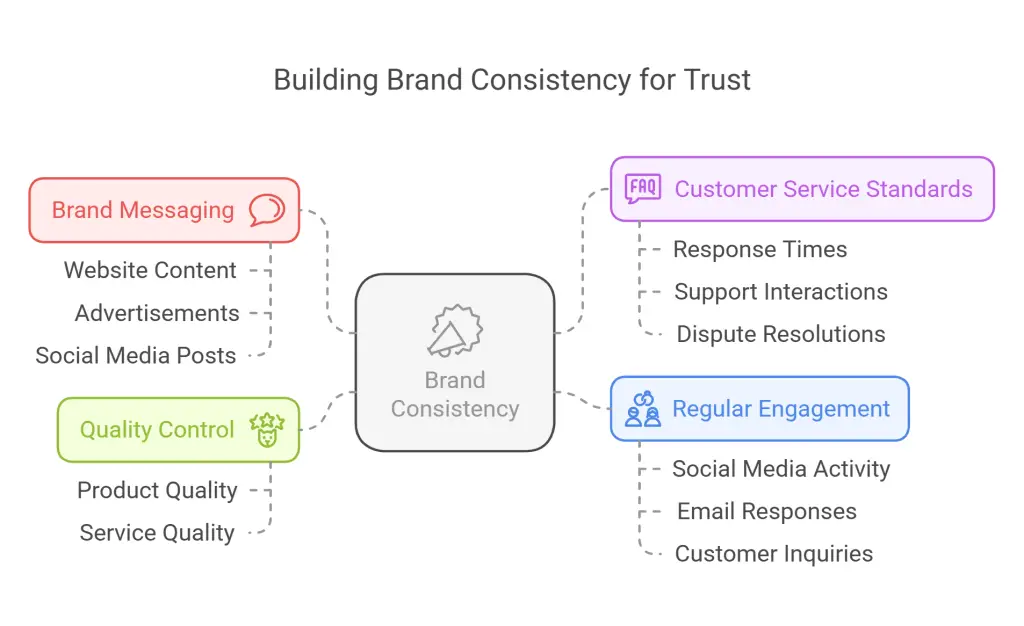
The Trust Triggers That Influence Buying Decisions
Transparency & Authenticity – The Key to Long-Term Trust
People buy from businesses they believe are honest and genuine. Small businesses that prioritize transparency in pricing, policies, and customer communication build deeper trust.
Transparency also extends to how a business handles mistakes. When companies openly acknowledge missteps and take responsibility, customers perceive them as more honest and ethical. Avoiding corporate jargon and being direct about pricing, service limitations, or potential delays enhances credibility.
Action Tip: Show behind-the-scenes content, admit mistakes when necessary, and clearly state pricing without hidden fees.
Social Proof – The Fastest Way to Build Trust
Social proof—reviews, testimonials, referrals—is one of the strongest psychological trust builders. When people see others vouching for a business, they feel safer making a purchase.
Word-of-mouth referrals are particularly powerful for small businesses. A strong referral network builds trust faster than any advertising campaign. Encouraging user-generated content, such as video testimonials or customer success stories, further humanizes the brand.
Action Tip:
- Ask satisfied customers for Google reviews and showcase them prominently.
- Share user-generated content (like customer photos or testimonials) on social media.
- Use case studies or before-and-after success stories.
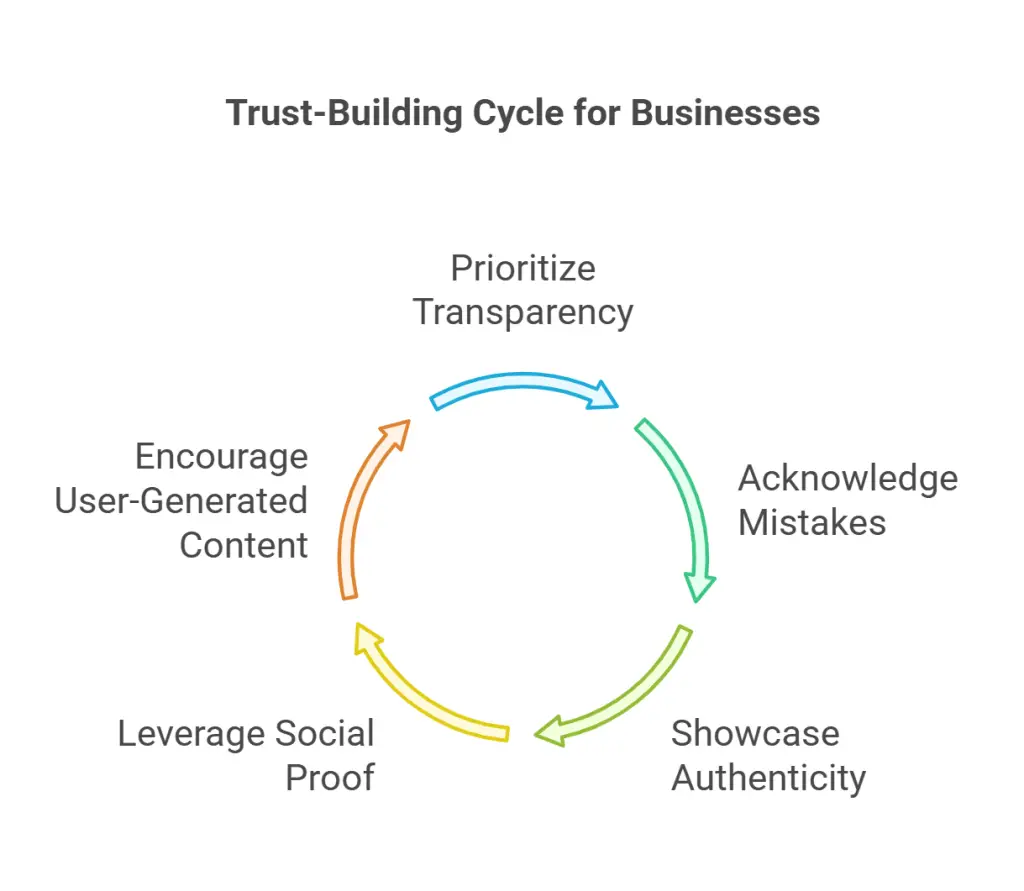
Authority & Credibility – Positioning Yourself as a Trusted Expert
Customers trust experts. A small business that positions itself as an authority in its industry earns customer confidence.
Action Tip:
- Publish educational content (blog posts, how-to guides, explainer videos).
- Get featured in local media or industry publications.
- Partner with trusted influencers or experts to boost credibility.
The Digital Side of Trust – Website, Social Media & Reviews
Trust is currency. If your business doesn’t look credible online, customers will hesitate—or worse, go to a competitor. Let’s break down the key digital trust signals that will make your website, social media, and reviews work in your favor.
Website Trust Signals – How to Make Your Site Feel Safe & Legitimate
A professional, secure website is the foundation of online trust. If a visitor lands on your page and spots amateur design, security warnings, or outdated content, they’ll likely leave within seconds. Here’s how to instantly boost your site’s credibility:
Must-Have Website Trust Elements:
✅ SSL certificate – HTTPS ensures a secure connection and signals legitimacy.
✅ Privacy policy & clear terms of service – Transparency matters.
✅ Trust badges – Secure payment icons, business accreditation, or industry certifications provide instant reassurance.
✅ Visible testimonials & case studies – Social proof helps visitors feel confident in choosing you.
✅ Professional design & easy navigation – A cluttered or outdated site screams untrustworthy.
✅ Fast-loading pages – A slow website isn’t just frustrating—it feels unreliable.
✅ Updated contact information – A real address, phone number, and email increase trust.
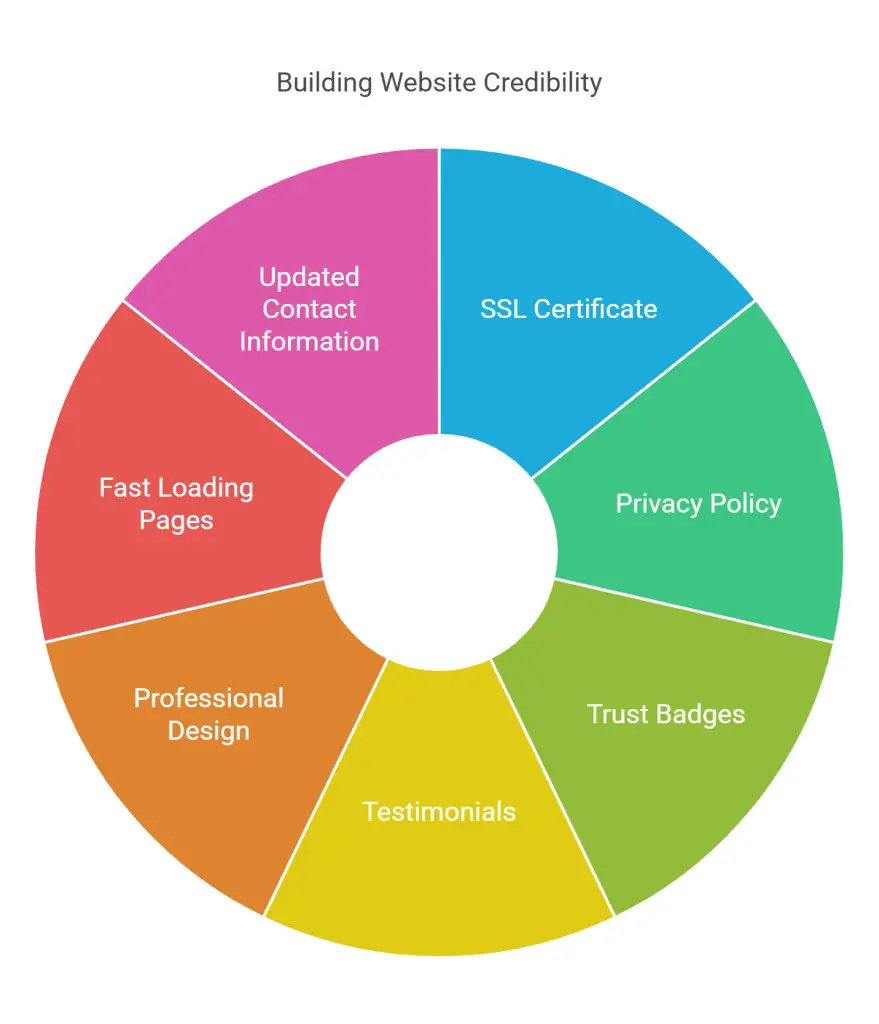
🎯 Action Tip: Audit your website today. If any of these elements are missing, update them ASAP. A polished, secure website isn’t just for looks—it directly impacts conversions.
Social Media & Engagement – A Platform for Trust-Building
A well-maintained social media presence reassures customers that your business is real, active, and engaged. If your profiles look abandoned, inconsistent, or unresponsive, it raises red flags. Here’s how to build trust through social media:
✅ Consistent branding – Your profile photos, bios, and content should match your website’s style.
✅ Regular posting – A dormant account looks suspicious. Aim for at least 3-4 posts per week.
✅ Authenticity over perfection – Customers connect with real stories, not staged perfection.
✅ Engagement matters – Respond to comments, DMs, and mentions to show you’re active.
✅ User-generated content & testimonials – Share customer reviews, photos, and experiences.
🚀 Action Tip: Schedule 10 minutes a day to engage with your audience—reply to comments, answer messages, and interact with followers. Consistency builds credibility over time.
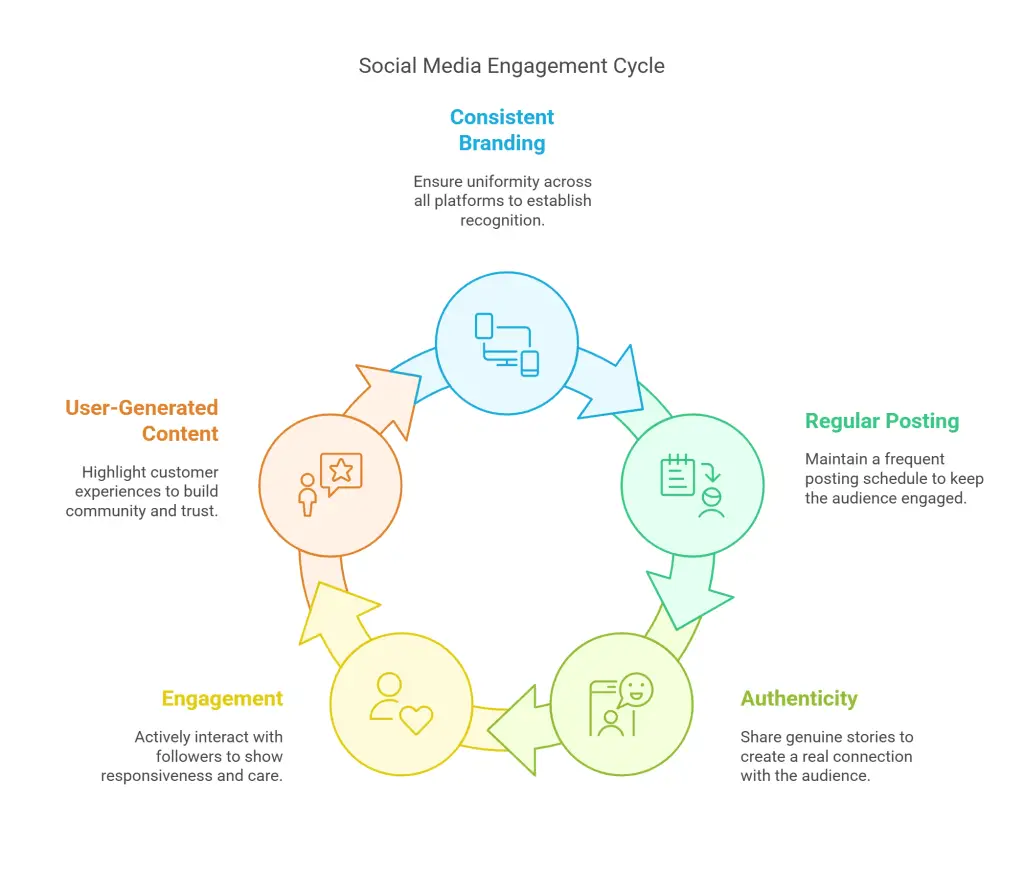
Handling Negative Reviews – The Right & Wrong Way
No business is perfect, and negative reviews happen. The real test is how you handle them. Ignoring or deleting bad reviews damages credibility. Instead, turn them into opportunities to showcase professionalism.
The Right Way to Respond to Negative Reviews
✅ Acknowledge the issue professionally – Never argue or get defensive.
✅ Apologize (if necessary) and offer a resolution – Show you care about customer satisfaction.
✅ Move the conversation offline if needed – A private resolution is often best.
✅ Encourage more positive reviews – Satisfied customers should be prompted to share their experiences.
📌 Example Response:
“We’re sorry to hear about your experience! We value your feedback and would love to make it right. Please reach out so we can help.”
❌ What NOT to Do:
- Ignore the review – It makes you look unresponsive.
- Get defensive – A public argument hurts your reputation.
- Delete it – Customers will notice and trust you less.
🎯 Action Tip: Monitor your reviews weekly and set up Google Alerts for brand mentions. Proactive reputation management keeps your business trustworthy.
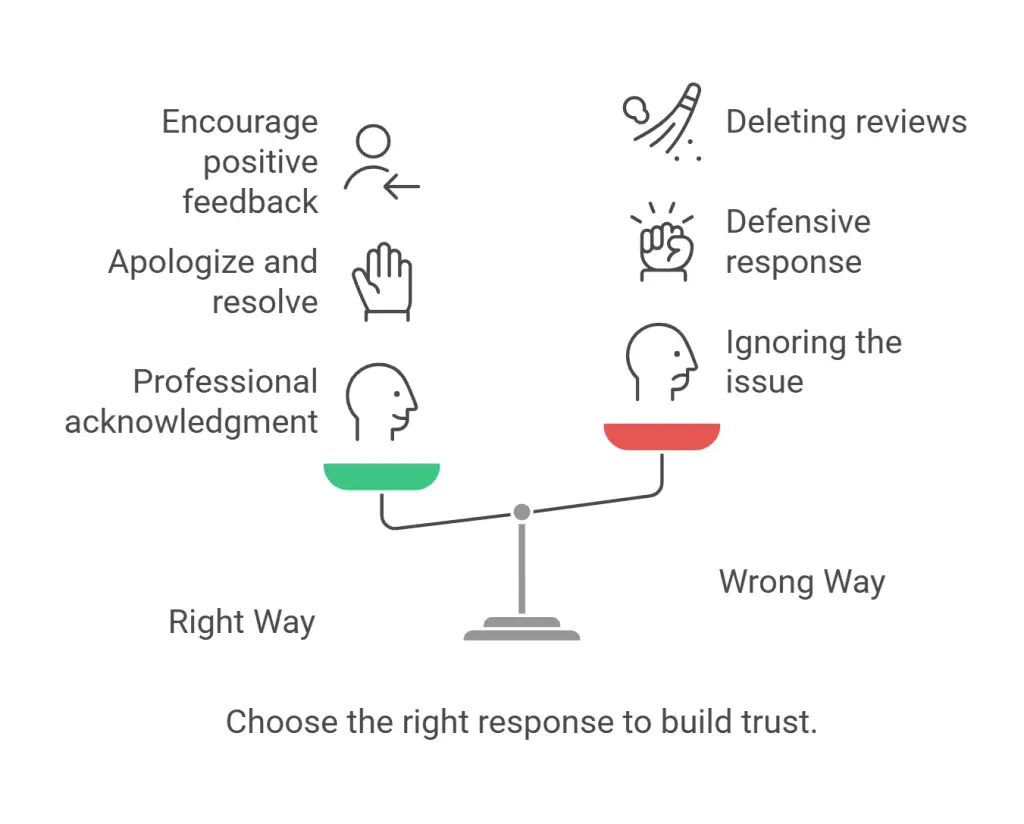
Common Trust Mistakes Small Businesses Make (And How to Fix Them)
Building trust with your audience is one of the most critical aspects of running a successful small business. Trust is what turns casual visitors into loyal customers, yet many small businesses unknowingly make mistakes that damage their credibility. Here are some of the most common trust-breaking mistakes and how to fix them.
🚨 Overpromising & Underdelivering
🔹 Mistake: Businesses often make bold claims in their marketing—such as “best in the industry” or “guaranteed results”—without the ability to back them up. Customers quickly lose trust when a company fails to meet expectations.
✅ Fix: Set realistic expectations and be transparent about what customers can truly expect. If you offer a money-back guarantee, outline the terms clearly. If delivery takes 5-7 days, don’t promise “instant shipping.” Managing customer expectations leads to greater satisfaction and repeat business.
🚨 Ignoring Customer Service Issues
🔹 Mistake: Customers expect prompt and helpful responses when they have a question or problem. Failing to address concerns in a timely manner makes a business appear unprofessional and untrustworthy.
✅ Fix: Respond to inquiries within 24 hours—even if you don’t have an immediate solution, acknowledging the issue reassures the customer that their concerns matter. Use automated responses for FAQs, but ensure real human interaction for more complex issues. Proactive communication builds confidence in your brand.
🚨 Inconsistent Branding & Messaging
🔹 Mistake: If your website says one thing, your social media another, and your emails something completely different, customers will feel uncertain about your business. Inconsistencies in tone, visuals, or promises make your brand seem unreliable.
✅ Fix: Ensure uniformity across all platforms. Your brand voice, messaging, and design elements should remain consistent across your website, social media, emails, and ads. A cohesive experience reassures customers that they’re dealing with a professional, trustworthy business.
🚨 Lack of Transparency in Pricing & Policies
🔹 Mistake: Hidden fees, unclear refund policies, or misleading pricing structures can quickly erode trust. If a customer only learns about additional costs at checkout, they’re likely to abandon the purchase and never return.
✅ Fix: Be upfront about pricing and policies. Display total costs, shipping fees, and any additional charges clearly before checkout. If you offer refunds, make the process easy to understand. Customers appreciate businesses that are honest and straightforward.
🚨 Neglecting Online Reviews & Social Proof
🔹 Mistake: Many small businesses either ignore negative reviews or don’t leverage positive ones. Potential customers heavily rely on reviews before making a purchase decision.
✅ Fix: Encourage satisfied customers to leave reviews on Google, Facebook, or other relevant platforms. Respond to negative reviews professionally, offering solutions rather than excuses. A business that actively manages its reputation earns more trust.
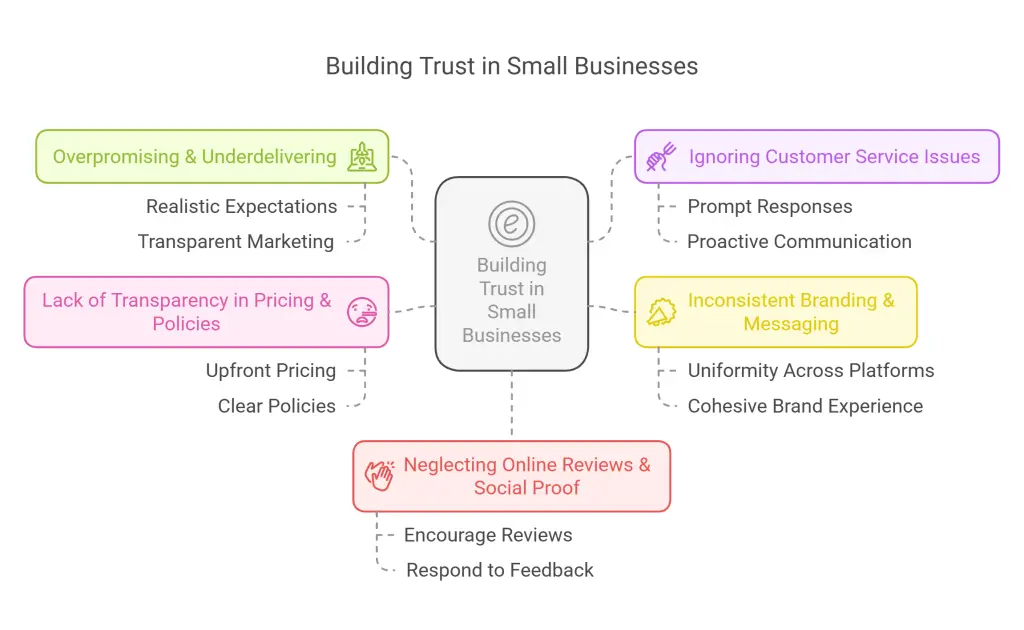
Action Tip:
🔍 Conduct a “trust audit” on your business by evaluating your website, social media, and customer interactions. Look for weak trust signals—such as inconsistent branding, unanswered messages, or unclear pricing—and take steps to fix them. Your ability to build and maintain trust will determine the long-term success of your business.
Case Study – How Brew Haven Café Used Trust to Increase Sales by 60%
The Business & Their Challenge
Brew Haven Café, a small, family-run coffee shop owned by Sarah and James Miller, prided itself on serving high-quality, ethically sourced coffee in the heart of their local community. Despite their exceptional in-store experience, they struggled to gain traction with online orders.

Customers were hesitant to order through their website due to a lack of reviews and visible credibility. Many potential buyers questioned whether the coffee would be as good as it was in-store, whether deliveries would be timely, and whether it was worth the effort compared to visiting in person.
Sarah and James knew that to grow their business, they needed to establish trust in their online ordering system.
The Trust-Building Strategies They Used
To overcome skepticism and encourage more customers to order online, Brew Haven Café implemented three key trust-building strategies:
✅ Showcased Customer Testimonials & Ratings on Their Website
They reached out to loyal customers and asked for honest feedback, incentivizing them with small discounts for leaving a review. By prominently displaying these positive testimonials and star ratings on their homepage, they reassured new visitors that their online ordering experience would be just as reliable as their in-store service.
✅ Shared Behind-the-Scenes Coffee Sourcing & Ethical Practices
To establish transparency and connect with conscious consumers, Brew Haven Café started posting behind-the-scenes content on their website and social media. They highlighted how they sourced their beans, the sustainable farming practices behind their blends, and the care put into each cup. This humanized their brand and built deeper connections with their audience.
✅ Engaged Daily on Instagram & Responded to All Reviews
Instead of just posting promotional content, Sarah and James started engaging directly with their community. They responded to every review, both positive and negative, demonstrating their commitment to customer satisfaction. Daily Instagram posts included customer shoutouts, brewing tips, and interactive polls to increase engagement.
The Results
🚀 Online orders increased by 60% in three months – More customers trusted the online ordering system, leading to a steady rise in digital sales.
🚀 Average customer spending rose by 25% – Customers who trusted the brand were more likely to add extra items to their cart, such as pastries and specialty drinks.
🚀 Social media engagement tripled – Their Instagram following grew, with more shares and comments boosting brand visibility.
By focusing on transparency, customer engagement, and social proof, Brew Haven Café successfully built trust and grew their sales.
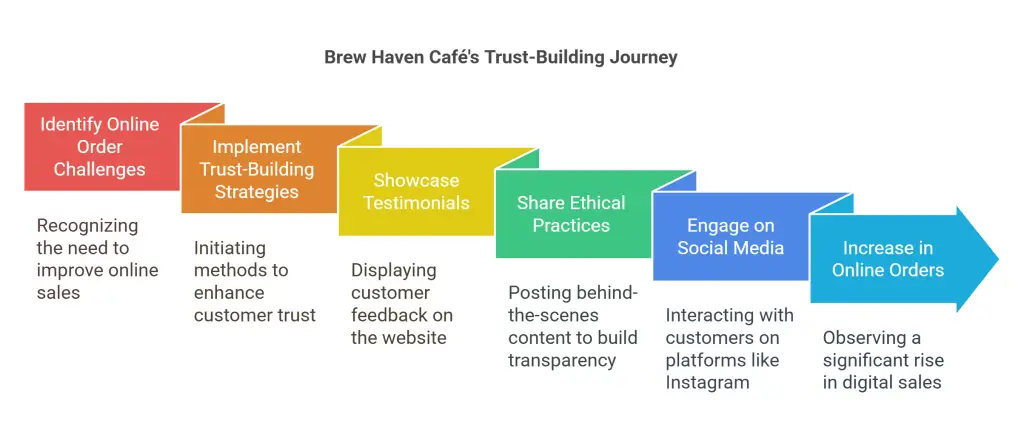
Key Takeaway:
Small businesses can significantly increase online sales with simple, consistent trust-building strategies. If customers feel confident about your service, they’ll keep coming back—and they’ll bring others with them.
How to Turn Trust Into Long-Term Customer Loyalty
Create a Strong Brand Story
People stay loyal to businesses that have a compelling mission. A strong brand story builds an emotional connection with your audience, making them feel like they are part of something bigger. Instead of just selling a product or service, show why your business exists and how it helps people.
A great example is TOMS Shoes, which built loyalty by promising to donate a pair of shoes for every purchase. Even small businesses can do this by sharing their founder’s journey, struggles, and victories.
Action Tip: Share your brand story on your website’s About page, social media, and email newsletters. Keep it authentic, relatable, and aligned with your audience’s values.
Use Guarantees, Refunds & Policies as Trust Builders
Clearly stating return/refund policies eliminates risk for buyers, making them more likely to purchase. A risk-free guarantee signals confidence in your product and reassures customers.
For example, offering a 30-day money-back guarantee can reduce hesitation, while a lifetime warranty can boost long-term trust. The easier your policies are to find and understand, the more customers will trust you.
Action Tip: Display trust signals prominently on product pages and checkout screens. Use customer-friendly language to reassure buyers.
Personalization & Relationship Marketing
A personal touch makes customers feel valued and connected. People are more likely to stay loyal to brands that recognize them as individuals rather than just another sale.
Ways to personalize customer interactions:
- Address customers by name in emails.
- Send personalized recommendations based on their purchase history.
- Offer special birthday or loyalty discounts.
Action Tip: Use a customer relationship management (CRM) system to track and personalize interactions, making your customers feel appreciated and understood.
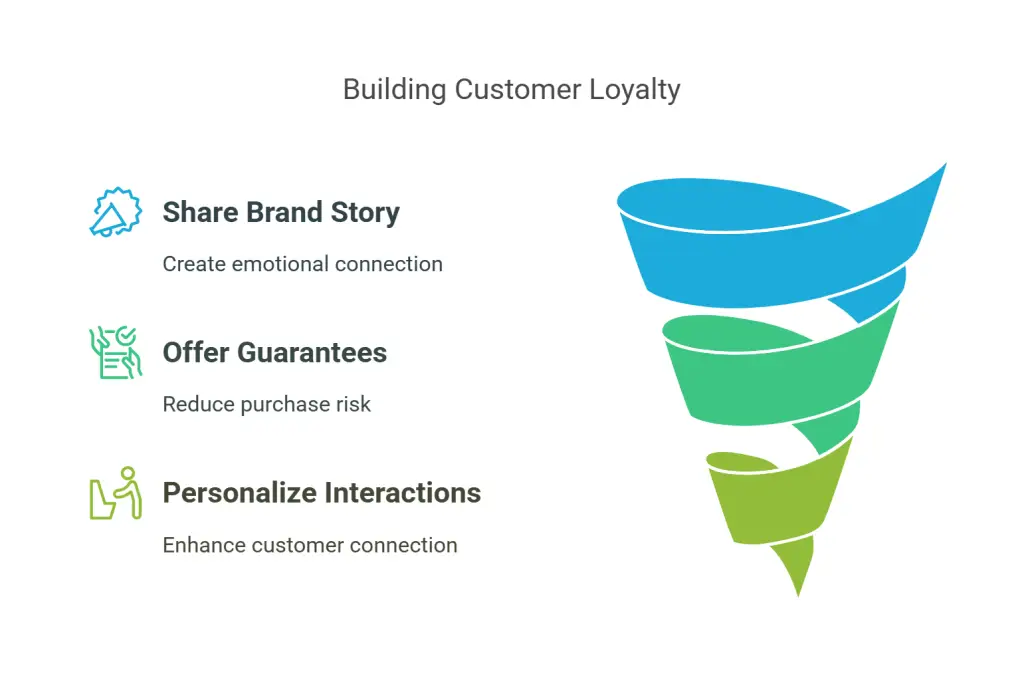
Conclusion: The Trust Audit Challenge
Recap Key Takeaways
✅ Trust reduces buyer hesitation and increases sales.
✅ Social proof and transparency are essential trust builders.
✅ A secure website, active social media, and strong branding enhance credibility.
Audit your business today: Does your website, branding, and customer service make people trust you?
Trust isn’t built overnight—it’s cultivated through consistent, transparent, and customer-focused actions. Every interaction, from your website design to how you respond to customer inquiries, plays a role in shaping how trustworthy your business appears. If your online presence lacks authenticity, potential customers will hesitate to take the next step.
Start by reviewing your website—does it clearly communicate who you are, what you offer, and why customers should choose you? Ensure your contact information is easy to find, your social proof is visible, and your brand messaging aligns with your audience’s expectations.
Beyond your website, trust extends to how you engage on social media. Are you responding to comments, addressing concerns, and showcasing real customer experiences? Transparency in communication and a strong online reputation foster lasting relationships.
By implementing these strategies, your small business can build trust, boost sales, and create long-term loyal customers. 🚀 Remember, trust is your strongest marketing asset—use it wisely!
Frequently Asked Questions
Why is trust crucial for small businesses?
Trust is essential for small businesses as it influences 81% of consumers’ buying decisions, leading to increased customer loyalty and higher conversion rates.
How can first impressions impact customer trust?
A professional, user-friendly website, clear brand messaging, visible contact information, and authentic visuals create a trustworthy first impression, encouraging customer engagement.
Why is consistency important in building trust?
Consistency in messaging, customer service, and product quality ensures customers know what to expect, reducing uncertainty and fostering trust in the brand.
What role does transparency play in establishing trust?
Transparency, through open communication and honesty about business practices, builds credibility and reassures customers, strengthening their trust in the business.
How do customer testimonials enhance trust?
Customer testimonials provide social proof, showcasing real experiences and satisfaction, which reinforces trust and encourages new customers to choose the business.
Fuirther reading
Tabrizi, Behnam, and David Eddie. “4 Questions to Measure and Boost Customer Trust.” Harvard Business Review, November 2022. https://hbr.org/2022/11/4-questions-to-measure-and-boost-customer-trust. Accessed February 16, 2025.
Zendesk. “How to Build Customer Trust.” Zendesk Blog, n.d. https://www.zendesk.com/au/blog/customer-trust/. Accessed February 16, 2025.
Gleeson, Brent. “5 Powerful Tips for Building Trust: From Culture to Customer Loyalty.” Forbes, October 20, 2024. https://www.forbes.com/sites/brentgleeson/2024/10/20/5-powerful-tips-for-building-trust-from-culture-to-customer-loyalty/. Accessed February 16, 2025.
HyperComply. “Why Is Customer Trust Important?” HyperComply Blog, n.d. https://www.hypercomply.com/blog/why-is-customer-trust-important. Accessed February 16, 2025.
Dixa. “5 Simple Ways You Can Build Customer Trust & Loyalty.” Dixa Blog, n.d. https://www.dixa.com/blog/5-simple-ways-you-can-build-customer-trust-loyalty/. Accessed February 16, 2025.
“Consumer Trust and Purchasing Decisions.” ScienceDirect, 2024. https://www.sciencedirect.com/science/article/pii/S1757780224000532. Accessed February 16, 2025.
CDP Institute. “81% of Consumers Say Trust Is a Deciding Factor in Purchasing, but Only 34% Trust Brands They Use.” CDP Institute News, n.d. https://www.cdpinstitute.org/news/81-of-consumers-say-trust-is-deciding-factor-in-purchasing-only-34-trust-brands-they-use/. Accessed February 16, 2025.
TEDx Talks. “Why Trust Is the New Currency in Business | Philippe de Ridder | TEDxVilvoorde.” YouTube, uploaded May 10, 2023. https://www.youtube.com/watch?v=1AGGY9g_kvo. Accessed February 16, 2025.
Simon Sinek. “The Importance of Trust in Business Leadership.” YouTube, uploaded September 12, 2023. https://www.youtube.com/watch?v=fXws6bHjbls. Accessed February 16, 2025.

